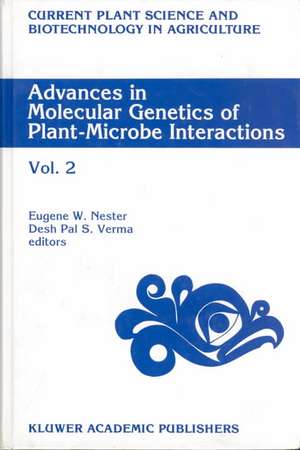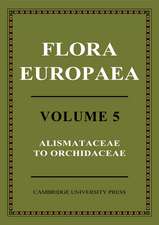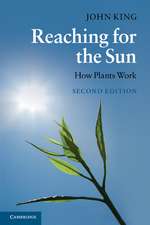Advances in Molecular Genetics of Plant-Microbe Interactions, Vol. 2: Proceedings of the 6th International Symposium on Molecular Plant-Microbe Interactions, Seattle, Washington, U.S.A., July 1992: Current Plant Science and Biotechnology in Agriculture, cartea 14
Editat de E.W. Nester, Desh Pal S. Vermaen Limba Engleză Hardback – 30 noi 1992
| Toate formatele și edițiile | Preț | Express |
|---|---|---|
| Paperback (1) | 1232.57 lei 6-8 săpt. | |
| SPRINGER NETHERLANDS – 28 oct 2010 | 1232.57 lei 6-8 săpt. | |
| Hardback (1) | 1239.19 lei 6-8 săpt. | |
| SPRINGER NETHERLANDS – 30 noi 1992 | 1239.19 lei 6-8 săpt. |
Din seria Current Plant Science and Biotechnology in Agriculture
-
 Preț: 414.14 lei
Preț: 414.14 lei - 18%
 Preț: 1232.57 lei
Preț: 1232.57 lei -
 Preț: 396.78 lei
Preț: 396.78 lei -
 Preț: 396.02 lei
Preț: 396.02 lei - 24%
 Preț: 1602.97 lei
Preț: 1602.97 lei - 18%
 Preț: 1234.46 lei
Preț: 1234.46 lei - 18%
 Preț: 1228.15 lei
Preț: 1228.15 lei - 18%
 Preț: 1846.58 lei
Preț: 1846.58 lei - 18%
 Preț: 955.40 lei
Preț: 955.40 lei -
 Preț: 450.88 lei
Preț: 450.88 lei - 18%
 Preț: 1228.15 lei
Preț: 1228.15 lei - 24%
 Preț: 1068.13 lei
Preț: 1068.13 lei - 18%
 Preț: 1229.28 lei
Preț: 1229.28 lei - 18%
 Preț: 1842.16 lei
Preț: 1842.16 lei - 18%
 Preț: 949.55 lei
Preț: 949.55 lei - 18%
 Preț: 1848.33 lei
Preț: 1848.33 lei - 18%
 Preț: 950.03 lei
Preț: 950.03 lei - 18%
 Preț: 955.25 lei
Preț: 955.25 lei - 18%
 Preț: 3041.41 lei
Preț: 3041.41 lei - 18%
 Preț: 1842.79 lei
Preț: 1842.79 lei - 18%
 Preț: 1838.38 lei
Preț: 1838.38 lei - 18%
 Preț: 1218.83 lei
Preț: 1218.83 lei - 18%
 Preț: 1243.78 lei
Preț: 1243.78 lei
Preț: 1239.19 lei
Preț vechi: 1511.20 lei
-18% Nou
Puncte Express: 1859
Preț estimativ în valută:
237.15€ • 246.67$ • 195.78£
237.15€ • 246.67$ • 195.78£
Carte tipărită la comandă
Livrare economică 14-28 aprilie
Preluare comenzi: 021 569.72.76
Specificații
ISBN-13: 9780792320456
ISBN-10: 079232045X
Pagini: 622
Ilustrații: XII, 622 p.
Dimensiuni: 156 x 234 x 35 mm
Greutate: 1.06 kg
Ediția:1993
Editura: SPRINGER NETHERLANDS
Colecția Springer
Seria Current Plant Science and Biotechnology in Agriculture
Locul publicării:Dordrecht, Netherlands
ISBN-10: 079232045X
Pagini: 622
Ilustrații: XII, 622 p.
Dimensiuni: 156 x 234 x 35 mm
Greutate: 1.06 kg
Ediția:1993
Editura: SPRINGER NETHERLANDS
Colecția Springer
Seria Current Plant Science and Biotechnology in Agriculture
Locul publicării:Dordrecht, Netherlands
Public țintă
ResearchCuprins
Research on Plant-Microbe Interactions: Making it relevant.- Cell-cell interactions during pollination in Brassica.- Overcoming pest and pathogen adaptability using insights from evolutionary biology.- The Virulence System of Agrobacterium tumefaciens.- Molecular and chemical analysis of signal perception by Agrobacterium.- A. Tumefaciens T-DNA transport: Roles for VirB, VirD2 and VirE2.- Identification of genetic factors controlling the ability of Agrobacterium to transfer DNA to maize.- Mechanism of T-DNA transfer.- Molecular interactions between Agrobacterium and plant cells.- Detection of avirulent mutants of Agrobacteriumtumefaciens in crown-gall tumors produced in vitro.- VirB4 is an inner membrane-associated protein essential for T-DNA transfer from Agrobacterium tumefaciens to plants.- The Rhizogenes tale: modification of plant growth and physiology by an enzymatic system of hydrolysis of phytohormone conjugates.- The Agrobacterium tumefaciens transcriptional activator OccR causes a bend at a target promoter that is partially relaxed by plant tumor metabolite.- Rhizobium nodulation factors: variations on a theme.- Control of nodule induction and plant cell growth by nod factors.- Rhizobial lipo-oligosaccharide signals: their biosynthesis and their role in the plant.- NodO: A nodulation protein that forms pores in membranes.- Nonflavonoid inducers of nod genes in Rhizobium meliloti: apparent NODD2 activators released naturally from alfalfa seeds add new dimensions to rhizosphere biology.- Role in nodulation and genetic regulation of exopolysaccharide synthesis in Rhizobium meliloti.- Oxygen regulation of nitrogen fixation gene expression in Rhizobiummeliloti.- Oxygen sensing and protein phosphorylation by the two-component regulatory FIXLJ system from Rhizobium meliloti.- Genetic and physiologic requirements for optimal bacteroid function in the Bradyrhizobium japonicum soybean symbiosis.- Determinants of specificty in the interaction of plants with bacterial pathogens.- A family of avirulence genes from Xanthomonasoryzae pv. Oryzae is involved in resistant interactions in rice.- Further characterization of genes encoding extracellular polysaccharide of Pseudomonas solanacearum and their regulation.- Physiological and genetic regulation of a pectate lyase structural gene, pel-I of Erwinia carotovora subsp. carotovora strain 71.- Oxidative stress response in Xanthomonas oryzae.- Involvement of Pseudomonas Solanacearumhrp genes on the secretion of a bacterial compound which induces a hypersensitive-like response on tobacco.- Pseudomonas syringae pv. phaseolicola-plant interactions: Host-pathogen signalling through cascade control of hrp gene expression.- Molecular genetic analysis of hrp and avirulence genes of Xanthomonascampestris pv. Vesicatoria.- Are harpins universal elicitors of the hypersensitive response of phytopathogenic bacteria?.- Molecular cloning and functions of avirulence and pathogenicity genes of the tomato pathogen Cladosporium fulvum.- Genome dynamics and pathotype evolution in the rice blast fungus.- Molecular basis of specificity in maize leaf spot disease.- The genetics of dimorphism in the smut fungi.- Genetical and functional organization of the a mating type locus of Ustilagomaydis.- Root nodule organogenesis and formation of the peribacteroid membrane compartment.- Early events in alfalfa nodule development.- Rhizobium nod metabolites and early nodulin gene expression.- Mechanisms of cell and tissue invasion by Rhizobium leguminosarum: The role of cell surface interactions.- Control of infection in thealfalfa-Rhizobium memiloti symbiosis.- Induction of genes encoding phenylpropanoid biosynthetic enzymes in soybean roots inoculated with B.japonicum, requires NOD gene induction and occurs independent of any known host functions.- Analysis of the Arabidopsis defense response to Pseudomonas pathogens.- Genetic approaches to an understanding of specific resistance responses of Arabidopsis thaliana against phytopathogenic Pseudomonads.- Identification of an Arabidopsis locus that governs avirulence gene-specific disease resistance.- Plant and bacterial genes involved in interactions between Xanthomonas and crucifers.- The identification and mapping of loci in Arabidopsis thaliana for recognition of the fungal pathogens: Peronospora parasitica (downy mildew) and Albugo candida (white blister).- Screening methods for Arabidopsis mutants affected in the signal transduction pathways leading to defense responses.- Towards positional cloning of the Pto bacterial resistance locus from tomato.- Studies on the mechanism by which tomato Cf (Cladosporium fulvum) resistance genes activate plant defence.- Molecular biology and biochemistry of Hml, a maize gene for fungal resistance.- Transposon tagging of a rust resistance gene in maize.- Glucan elicitor-binding proteins and signal transduction in the activation of plant defence.- Elicitor recognition and intracellular signal transduction in plant defense.- Transcriptional regulation of phytoalexin biosynthetic genes.- Mutagenesis of a race-specific rust resistance gene in Antirrhinum majus using a transposon-tagging protocol.- Molecular markers and genome analysis in the manipulation of lettuce downy mildew.- Systematic acquired resistance in tobacco: Use of transgenic expression to study the functions of pathogenesis-related proteins.- Genetic and biochemical determinants of phenazine antibiotic production in fluorescent pseudomonads that suppress take-all disease of wheat.- A biological sensor for iron that is available to Pseudomonas fluorescens inhabiting the plant rhizosphere.- Characteristics and applications of antibodies produced in plants.- Application of microinjection technique for the analysis of gene expression during host-parasite interaction.- Resistance to Rhizoctonia solani in transgenic tobacco.- Antibacterial resistance of transgenic potato plants producing T4 lysozyme.- Pathogen-derived strategy to produce transgenic plants resistant to the bacterial toxin phaseolotoxin.- A universally conserved vital protein revealed by victorin binding.- Nitrogen fixation of Azorhizobium in artificially induced root para-nodules in wheat.- Name Index.









